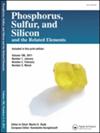焦硅酸盐、焦磷酸盐和焦硫酸盐阴离子与新设计阴离子受体配位过程中的芳香性监测
IF 1.4
4区 化学
Q4 CHEMISTRY, INORGANIC & NUCLEAR
Phosphorus, Sulfur, and Silicon and the Related Elements
Pub Date : 2025-05-04
DOI:10.1080/10426507.2025.2490163
引用次数: 0
摘要
氧离子的定量由于其与代谢过程和各种疾病的相关性而日益引起人们的兴趣。然而,现有的大多数分析方法往往在现场适用性、灵敏度和用户友好性方面存在不足。采用ωB97XD/6-311++g(d,p)密度泛函数法研究了新设计的有机阴离子受体1H-dipyrrolo[3,2-b:2 ',3 ' -d]pyrrol -1,7(4H)-二基)双硼烷腈(DPBB)在三种氧阴离子:焦硅酸盐(Si2O7)6−、焦磷酸盐(P2O7)4−和焦硫酸盐(S2O7)2−的气相负离子亲和力。计算得到的阴离子亲和在348.12 ~ 1905.94 kJ mol−1之间。通过电子离域谐振子模型(HOMED)、BIRD和SHANNON指数监测阴离子对DPBB结构的诱导芳构性。结果表明,(P2O7)4−@DPBB配合物的左、中、右环诱导芳香性指数分别为0.94、0.65、0.94 (HOMED)、73.35、46.59、73.17 (BIRD)和0.0005033、0.0026009、0.0005033 (SHANNON),诱导芳香性最高。本文章由计算机程序翻译,如有差异,请以英文原文为准。
Aromaticity monitoring during the donor-acceptor coordination of pyrosilicate, pyrophosphate, and pyrosulfate anions to a new designed anion receptor
The quantification of oxyanions is of increasing interest due to its relevance to metabolic processes and various diseases. However, the majority of the existing analytical methods often fall short in terms of on-site applicability, sensitivity, and user-friendliness. The ωB97XD/6-311++g(d,p) density functional method was utilized to study the anion affinities of a new designed organic anion receptor (1H-dipyrrolo[3,2-b:2′,3′-d]pyrrole-1,7(4H)-diyl) bis(boranecarbonitrile) (DPBB) in the gas phase for three oxyanions: pyrosilicate (Si2O7)6−, pyrophosphate (P2O7)4−, and pyrosulfate (S2O7)2−. The calculated anion affinities obtained were in the range of 348.12–1905.94 kJ mol−1. The induced aromaticity by the studied anions on DPBB structure was monitored via the harmonic oscillator model of electron delocalization (HOMED), BIRD, and SHANNON indices. According to the obtained results, (P2O7)4−@DPBB complex showing 0.94, 0.65, 0.94 (HOMED), 73.35, 46.59, 73.17 (BIRD), and 0.0005033, 0.0026009, 0.0005033 (SHANNON) indices for the left, middle, and right side rings, respectively, demonstrated the highest induced aromaticity.
求助全文
通过发布文献求助,成功后即可免费获取论文全文。
去求助
来源期刊
CiteScore
2.60
自引率
7.70%
发文量
103
审稿时长
2.1 months
期刊介绍:
Phosphorus, Sulfur, and Silicon and the Related Elements is a monthly publication intended to disseminate current trends and novel methods to those working in the broad and interdisciplinary field of heteroatom chemistry.

 求助内容:
求助内容: 应助结果提醒方式:
应助结果提醒方式:


